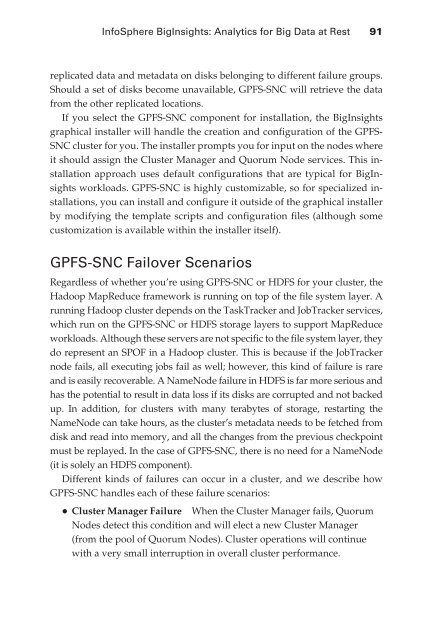Analytics for Enterprise Class Hadoop and Streaming Data
Analytics for Enterprise Class Hadoop and Streaming Data
Analytics for Enterprise Class Hadoop and Streaming Data
Create successful ePaper yourself
Turn your PDF publications into a flip-book with our unique Google optimized e-Paper software.
InfoSphere BigInsights: <strong>Analytics</strong> <strong>for</strong> Big <strong>Data</strong> at Rest 91<br />
replicated data <strong>and</strong> metadata on disks belonging to different failure groups.<br />
Should a set of disks become unavailable, GPFS-SNC will retrieve the data<br />
from the other replicated locations.<br />
If you select the GPFS-SNC component <strong>for</strong> installation, the BigInsights<br />
graphical installer will h<strong>and</strong>le the creation <strong>and</strong> configuration of the GPFS-<br />
SNC cluster <strong>for</strong> you. The installer prompts you <strong>for</strong> input on the nodes where<br />
it should assign the Cluster Manager <strong>and</strong> Quorum Node services. This installation<br />
approach uses default configurations that are typical <strong>for</strong> BigInsights<br />
workloads. GPFS-SNC is highly customizable, so <strong>for</strong> specialized installations,<br />
you can install <strong>and</strong> configure it outside of the graphical installer<br />
by modifying the template scripts <strong>and</strong> configuration files (although some<br />
customization is available within the installer itself).<br />
GPFS-SNC Failover Scenarios<br />
Regardless of whether you’re using GPFS-SNC or HDFS <strong>for</strong> your cluster, the<br />
<strong>Hadoop</strong> MapReduce framework is running on top of the file system layer. A<br />
running <strong>Hadoop</strong> cluster depends on the TaskTracker <strong>and</strong> JobTracker services,<br />
which run on the GPFS-SNC or HDFS storage layers to support MapReduce<br />
workloads. Although these servers are not specific to the file system layer, they<br />
do represent an SPOF in a <strong>Hadoop</strong> cluster. This is because if the JobTracker<br />
node fails, all executing jobs fail as well; however, this kind of failure is rare<br />
<strong>and</strong> is easily recoverable. A NameNode failure in HDFS is far more serious <strong>and</strong><br />
has the potential to result in data loss if its disks are corrupted <strong>and</strong> not backed<br />
up. In addition, <strong>for</strong> clusters with many terabytes of storage, restarting the<br />
NameNode can take hours, as the cluster’s metadata needs to be fetched from<br />
disk <strong>and</strong> read into memory, <strong>and</strong> all the changes from the previous checkpoint<br />
must be replayed. In the case of GPFS-SNC, there is no need <strong>for</strong> a NameNode<br />
(it is solely an HDFS component).<br />
Different kinds of failures can occur in a cluster, <strong>and</strong> we describe how<br />
GPFS-SNC h<strong>and</strong>les each of these failure scenarios:<br />
• Cluster Manager Failure When the Cluster Manager fails, Quorum<br />
Nodes detect this condition <strong>and</strong> will elect a new Cluster Manager<br />
(from the pool of Quorum Nodes). Cluster operations will continue<br />
with a very small interruption in overall cluster per<strong>for</strong>mance.

















